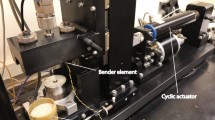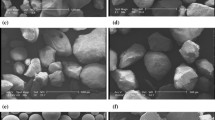Abstract
Three silica sand samples—well graded, intermediately graded, and narrowly graded—having different uniformity coefficients, were constituted to allow the investigation of the influence of particle size distribution on their mechanical behavior. Using a ring shear apparatus, samples were tested under a wide range of laboratory conditions. Results of the tests clearly indicate that, for specimens confined under identical stress conditions, well-graded specimens have higher values of peak and steady state strengths than the rest of the specimens. A relationship between uniformity coefficient and shear strengths shows that the higher the uniformity coefficient, the higher the shear strength. On account of these, well-graded specimens have higher static liquefaction resistance than the poorly graded specimens. Within the range of normal stresses employed in the tests, results reveal that not only are poorly graded sands more likely to suffer higher postfailure strength reduction, but that their steady-state strengths are easily reduced to zero, the magnitude of the confining stress notwithstanding. This reduction of shear resistance to zero has been described as complete liquefaction in this paper. While almost all of the narrowly graded specimens suffered complete liquefaction, widely graded ones did not; an observation that seem to highlight the influence of grading on the mechanical behavior of the sands.















Similar content being viewed by others
References
Alarcon-Guzman A, Leonards GA, Chameau JL (1988) Undrained monotonic and cyclic strength of sands. J Geotech Eng Div 114(10):1089–1109
Bishop AW (1971) Shear strength parameters for undisturbed and remoulded soil specimens. Stress–strain behavior of soils. RHG Parry Ed, Cambridge University, Cambridge, UK, pp 3-58
Bishop AW (1973) Stability of spoil heap. Q J Eng Geol 6:335–376
Casagrande A (1936) Characteristics of cohesionless soils affecting the stability of slopes and earth fills. J Boston Soc Civ Eng 23(1):13–32
Casagrande A (1976) Liquefaction and cyclic mobility of sands: a critical review. Harvard soil mechanics series, no. 88. Harvard University, Cambridge, MA
Castro G (1969) Liquefaction of sands. Ph.D. thesis, Harvard University, Cambridge, MA
Castro G, Poulos SJ (1977) Factors affecting liquefaction and cyclic mobility. J Geotech Eng Div 103(GT6):501–516
Finn WDL, Bransby PL, Pickering DJ (1970) Effect of strain history on liquefaction of sands. J Soil Mech Found Div 97(SM6):1917–1934 (proceedings paper 7670)
Hardin BO, Drenevich VP (1972a) Shear modulus and damping in soils: design equations and curves. J Soil Mech Found Div 98(SM7):667–692 (proceedings paper 9006)
Hardin BO, Drenevich VP (1972b) Shear modulus and damping in soils: measurement and parameter effects. J Soil Mech Found Div 98(SM6):603–624 (proceedings paper 8977)
Herrera I (1964) Dinamicos para Materiales y Estructuras del Tipo Masing. Bol Soc Mex Ing Sism 3(1):1–8
Hutchinson B, Townsend D (1961) Some grading–density relationships for sands. Proceedings, 5th international conference on soil mechanics and foundation engineering, vol 1, pp 159–163
Kokusho T, Hara T, Hiraoka R (2004) Undrained shear strength of granular soils with different particle gradations. J Geotech Geoenviron Eng 130(6):621–629
Kondner RL, Zelasko JS (1963) A hyperbolic stress–strain formulation for sands. Proceedings, 2nd Pan American conference on soil mechanics and foundation engineering, pp 289–324
Konrad JM (1993) Undrained response of loosely compacted sands during monotonic and cyclic compression tests. Geotechnique 43(1):69–89
Kramer SL, Seed HB (1988) Initiation of soil liquefaction under static loading conditions. J Geotech Eng 114(4):412–430
Lade PV, Pradel D (1990) Instability and plastic flow of soils. Experimental observations. J Eng Mech 116(11):2500–2532
Negussey D, Wijewickreme WKD, Vaid YP (1988) Constant-volume friction angle of granular materials. Can Geotech J 25:50–55
Newmark NM, Rosenblueth E (1971) Fundamentals of earthquake engineering. Prentice-Hall, Englewood Cliffs, NJ, pp 162–163
Poulos SJ (1981) The steady state of deformation. J Geotech Eng Div 107(GT5):553–562
Poulos SJ, Castro G, France JW (1985) Liquefaction evaluation procedure. J Geotech Eng Div 111(6):772–792
Pyke RM (1973) Settlement and liquefaction of sands under multidirectional loading. Ph.D. thesis, University of California, Berkeley, CA
Sasitharan S, Robertson PK, Sego DC, Morgenstern NR (1993) Collapse behavior of sand. Can Geotech J 30:569–577
Sasitharan S, Robertson PK, Sego DC, Morgenstern NR (1994) State-boundary surface for very loose sand and its practical implications. Can Geotech J 31:321–334
Sassa K (1985) The mechanism of debris flow. In: Proceedings of the 11th international conference on soil mechanics and foundation engineering, San Francisco, CA, vol 3, pp 1173–1176
Sassa K (1988) Geotechnical model for the motion of landslides. Special lecture of the 5th international symposium on landslides, ‘landslides’, vol 1. Balkema, Rotterdam, pp 37–55
Sassa K (2000) Mechanism of flows in granular soils. Proceedings of the GeoEng2000, Melbourne, vol 1, pp 1671–1702
Sassa K, Gonghui W, Fukuoka H (2003) Performing undrained shear test on saturated sands in a new intelligent type ring shear apparatus. Geotech Testing J 26(3):1–9
Seed HB, Idris IM (1971) Simplified procedures for evaluating soil liquefaction potential. J Soil Mech Found Engr Am. Soc. Civ. Engrs. GT3 109:458–482
Seed HB, Idriss IM (1969) Influence of soil conditions on ground motions during earthquakes. J Soil Mech Found Div 95(SM1):99–137 (proceedings paper 6347)
Sladen JA, D’Hollander RD, Krahn J (1985) The liquefaction of sands, a collapse surface approach. Can Geotech J 22:564–578
Vaid YP, Chern JC (1985) Cyclic and monotonic undrained response of saturated sands. Advances in the art of testing soils under cyclic conditions. American Society of Civil Engineers Convention, Detroit, MI, pp 120–147
Vaid YP, Fisher JM, Kuerbis RH, Negussey D (1990) Particle gradation and liquefaction. J Geotech Eng 116(4):698–703
Vasquez-Herrera A, Dobry R, Ng TT (1988) Pore pressure build-up and liquefaction failure of anisotropically consolidated sand due to cyclic straining. Proceedings of conference on hydraulic fill structures, Fort Collins. American Society of Engineers, New York, pp 346–366
Wafid MA, Sassa K, Fukuoka H, Wang G (2004) Evolution of shear-zone in undrained ring shear tests. Landslides J Int Consort Landslides 1:101–112
Wang G, Sassa K (2001) Factor affecting the rainfall-induced flowslides in laboratory flume tests. Geotechnique 51(7):587–599
Wang G, Sassa K (2002) Post-failure mobility of saturated sands in undrained load-controlled ring shear tests. Can Geotech J 39:821–837
Yamamuro JA, Lade PV (1999) Experiments and modeling of silty sands susceptible to static liquefaction. Mech Cohes-Frict Mater 4(6):545–564
Yoshimine M, Robertson PK, Wride CE (1999) Undrained shear strength of clean sands to trigger flow liquefaction. Can Geotech J 36:891–906
Author information
Authors and Affiliations
Corresponding author
Rights and permissions
About this article
Cite this article
Igwe, O., Sassa, K. & Wang, F. The influence of grading on the shear strength of loose sands in stress-controlled ring shear tests. Landslides 4, 43–51 (2007). https://doi.org/10.1007/s10346-006-0051-2
Received:
Accepted:
Published:
Issue Date:
DOI: https://doi.org/10.1007/s10346-006-0051-2




